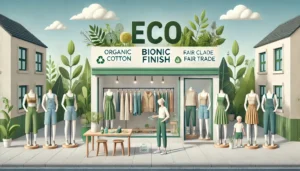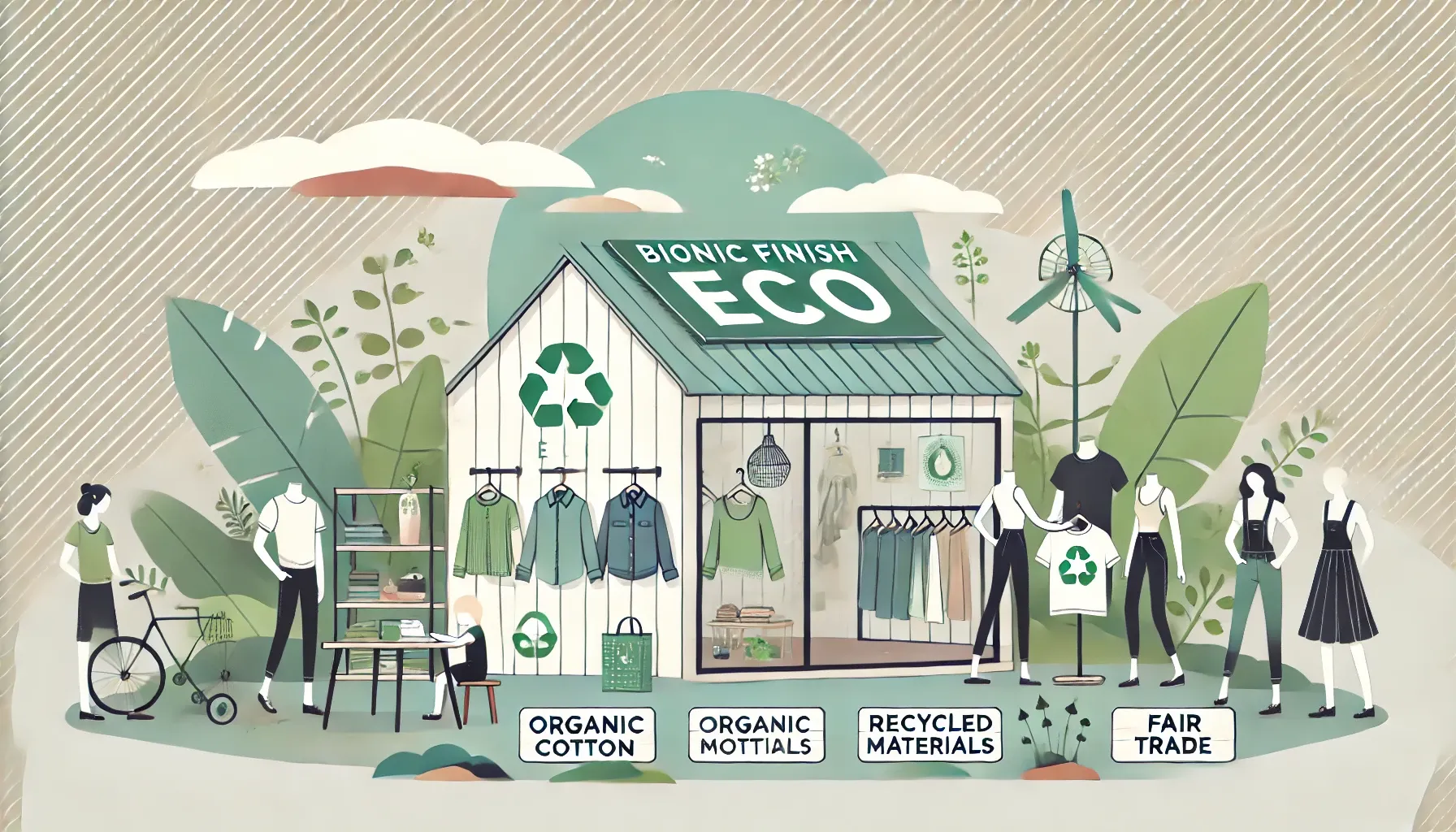Introduction
Glamour and high aesthetics were once all synonyms of the fashion industry, but now it has become more than only a matter for the fans as its environmental implications garner global scrutiny. The industry is changing in the face of growing concern about climate change and sustainability changes not seen since a grasshopper army rose up to consume it. One of the top-notch solutions is Bionic Finish Eco, a textile treatment that is heralded as groundbreaking for providing eco-friendly water-repellence without harmful chemicals. Continue reading for a deep dive into Bionic Finish Eco, its history and benefits, and possible practical applications within the realm of sustainable fashion.

Sustainable Fashion in the Limelight
Eco-fashion, also called sustainable fashion, is a part of the growing design philosophy and trend in which clothing is made not only to be hot and/or comfy but also reverence environmental impact. However, it was only in the latter part of the 20th century that this movement came to prominence as a response to growing concerns around pollution levels and environmental impact generated by conventional fashion practices. Environmental worries include water pollution, waste, and carbon emissions, as well as increased use of non-renewable resources.
Principle of Sustainable Fashion
Increasing Environmental Awareness: Rising public exposure towards climate change and environmental clearance activities has nudged the populace to increase demand for sustainable products.
Consumer Demand: Modern consumers are looking for ethical products.
Regulatory Pressures: Governments across the world are coming up with stricter regulations to mitigate industrial pollution and further sustainable operations.
Corporate Responsibility: To ensure the brand image and meet up stakeholder needs, you will see more CSR activities, thereby increasing your client base.
Understanding Bionic Finish Eco
Bionic Finish Eco was developed by Rudolf Group, which is the leading company within textiles when it comes to high-performance chemistry. Offering water and stain repellency to fabrics without the use of perfluorinated compounds (PFCs) that are known for their environmental persistence, this groundbreaking finish has been engineered.
This article will discuss the properties of Bionic Finish Eco and why you should use it on your rain gear.
- Water-repellent Bionic Finish Eco is free from perfluorinated compounds.
- Strength: Water and oil repellent properties are durable up to 15 industrial washes, yet the soft hand remains.
- Breathable finish: this means that the fabric is not spoiled to prevent perspiration on hot days.
- Eco-friendly: It biodegrades and has a natural impervious system imitating plants.
The Science of Bionic Finish Eco
Bionic Finish Eco works with a biomimetic (imitating nature) approach. In nature, many plants are superhydrophobic (water-repellent) such as the well-known example of the lotus leaf. This led to the creation of Bionic Finish Eco, based on a principle called the Lotus Effect.
The Lotus Effect:
- Micro and Nanostructures: Like on the lotus leaf, micro-bumps create air pockets that prevent water from wetting it as well.
- Hydrophobic Waxes: These hydrophobic (water-repelling) waxes coat the structure to provide even more water resistance.
Bionic Finish Eco imitates those natural strategies and offers the same level of high-performance water repellency, all without using extremely harmful synthetic chemicals.
The Applications for Bionic Finish Eco
Bionic Finish Eco is versatile with a broad range of applications, which has made it the go-to choice for different industries within fashion.
- Apparel:
- Outerwear: Outerwear is protected to repel more water effectively as well and be more durable.
- Athletic wear: The need for breathable, water-repellent fabrics make this a great fit for Bionic Finish Eco.
- Casual Wear: Jeans and shirts are not just regular everyday clothing anymore; they serve something more now!
- Home Textiles:
- Furniture: Fabrics treated with Bionic Finish Eco have decreased hazards for human health while making the fabric easier to clean and maintain.
- Curtains: Window treatments can repel dust and moisture, which will stretch out their life so you have to buy new ones less frequently.
- Bedding: Mattresses and sheets are made stain resistant.
- Technical Textiles:
- Hospital gowns and bedding: Medical textiles allow for better hygiene and cleanliness.
- Hardy, Water-Resistant Apparel: Suitable for industrial workers or law enforcement.
Benefits of Bionic Finish Eco
Bionic Finish Eco provides several benefits, all fitting into the space of sustainable fashion.
- Environmental Benefits:
- Decreased Chemical Toxins: Removal of PFCs sharply reduces the outflowing toxicity back to nature.
- Decomposition: The finish decomposes, ensuring long-term harm reduction to the environment.
- Sustainable: Less energy is needed in the application process than conventional finishes, resulting in lower carbon footprints.
- Consumer Benefits:
- Health: Decreasing PFC use will lower emissions and reduce potential health risks from chemical exposure.
- Breathability: Helps wearer comfort, especially in active or outdoor conditions.
- Easy to Clean: Clothing and textiles with water and stain resistance can be easily cleaned, reducing the hours of scrubbing.
- Economic Benefits:
- Consumer Appeal: Bionic Finish Eco can provide companies with a means to differentiate themselves in the market.
- Compliance: Staying in line with local regulations can create a barrier from expensive fines and boost brand reputation.
- Long-Term Savings: Long-lasting finishes decrease the need for repeat purchases, saving money over time.
Future Prospects and Challenges
The advantages of Bionic Finish Eco are many, but it also encounters problems of acceptance.
- Challenges:
- Expenses: Adopting eco-friendly processes often have a higher price point compared to traditional methods in the initial stages.
- Consumer Knowledge: It is important that consumers are equipped with knowledge about the long-term benefits of sustainable finishes, to build market acceptance.
- Technical Challenges: Complexity to make it compatible with different types of textiles and maintain the performance standards.
- Future Prospects:
- Future innovation will likely make greener finishes perform better and cost less. As regulatory pressures for greater transparency and consumer demands continue to push the needle, momentum is picking up in the fashion industry as well.
Conclusion
All in all, the use of Bionic Finish Eco is a huge step forward and can help to transform fashion into being more eco-friendly. It eliminates the use of toxic chemicals and is also non-carcinogenic, making it a genuinely green solution for consumers willing to take eco-friendly approaches. To make fashion more durable and sustainable for special occasions and everyday wear, the adoption of such innovations will be important to strike a balance between style and functionality while being environmentally conscious as the evolution in the keenly changing fashionscape intensifies.
The road to genuine sustainable fashion is far from over; however, advancements such as Bionic Finish Eco are making it that bit easier. There is no doubt that the dream of a more eco-friendly and ethical fashion landscape appears to be in reach, as Paper Plane has piqued interest while conversations about sustainability become mainstream discussions.
